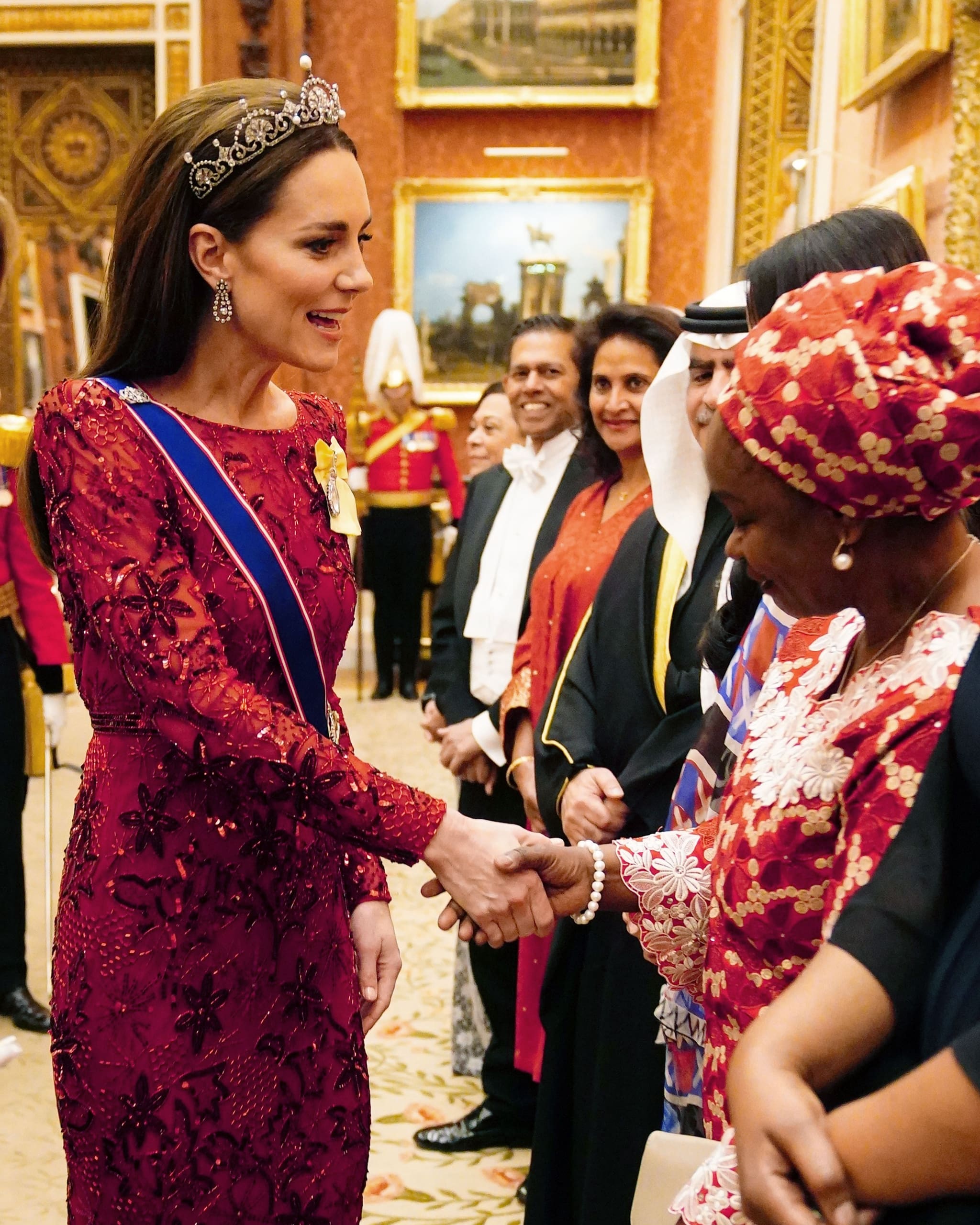Getty Images
In total, there will only be three crowns in the strictest sense in Westminster Abbey today – each of which features stones whose provenance has caused highly understandable discord. The first is, of course, St Edward’s Crown, created by Royal Goldsmith Robert Vyner for the Coronation of Charles II in 1611 and used in the moment of crowning itself. Its design is allegedly based on the crown made for Edward the Confessor in the 11th century – one of many royal objects believed to have been melted down following the execution of Charles I in 1649 and the subsequent establishment of the Commonwealth. Set with rubies, amethysts, garnets, tourmalines, sapphires and topaz and lined with purple velvet and ermine trim, the 17th-century frame weighs in at nearly five pounds in total. Before her own Coronation, the Queen would wear St Edward’s Crown at her desk while going through her red state boxes in preparation for the ceremony.
Before leaving Westminster Abbey following the service, however, King Charles III will switch St Edward’s Crown for the Imperial State Crown. Worn by the monarch during the State Opening of Parliament each year, the latter is set with nearly 2,000 diamonds, including the Cullinan II, and a sapphire said to be from a ring belonging to Edward the Confessor.
As for Queen Consort Camilla? Her Majesty will be crowned with Queen Mary’s Crown, designed by Garrard for the 1911 Coronation of King George V, which has been set with Cullinan diamonds III, IV and V. The latter two stones were favourites of the late Queen Elizabeth II, which she often wore together in a brooch. Gifted to her by her grandmother, Queen Mary, they were known as Granny’s Chips – a reference to both Mary and the fact that they were “chipped” off the primary Cullinan diamond, the largest ever found. Per Buckingham Palace, this is the first time a Queen has declined to have a crown made specifically for a Coronation – a move intended as a gesture towards sustainability.

There are likely to be a number of further coronets and tiaras among the congregation gathered in Westminster Abbey, too – although just how many remains to be seen. Male members of the British aristocracy – ie, dukes, marquesses, earls, viscounts and barons – have traditionally worn velvet cloaks lined with ermine to Coronations, paired with coronets that indicate their rank through their level of adornment. Coronets only differ from crowns in terms of their size and relative simplicity. According to Debrett’s, a duke’s coronet – the most elaborate – comprises a “circlet of silver-gilt” adorned with “eight strawberry leaves”, while a baron’s “as befits the lowest rank, is the plainest design, with just six silver balls”.
In accordance with King Charles’s vision for a more pared-back Coronation, however, members of the House of Lords were initially told to leave both their robes and coronets at home and wear suits instead. (The official dress code for the ceremony is simply “day wear”.) Now, though, it seems as if certain peers have persuaded Buckingham Palace to let them wear their full regalia – meaning strawberry leaves and silver balls are both back on the menu. As for tiaras? Anyone can technically wear one on the day – although traditionally diadems are reserved for married aristocratic women, particularly at Coronations. Still, at the Queen’s Coronation, “even the young ladies in the choir orchestra playing the harp and the oboe [were] wearing tiaras and white veils,” Cecil Beaton noted in his 1953 coverage for Vogue.

That being said, it’s been rumoured for weeks now that the Princess of Wales will eschew a tiara in favour of a floral headpiece – which is less of a break from tradition than many have assumed, and aligns with the tone of Charles’s Coronation overall. In every stage of planning, the King and Queen Consort have put the British landscape – and the need to both celebrate and protect it – front and centre. Take their decision to include dog roses and bluebells, wild strawberries and cornflowers in the official Coronation invite, and to deck Westminster Abbey with boughs, shrubs and blooms from across the British Isles.
Of course, all manner of flowers have been immortalised in diamond tiaras for the royal family over the years – Princess Margaret famously loved the Lotus Flower Tiara, in particular – but precious stones haven’t always been the order of the day at formal events. The late Queen’s attendants actually wore silk floral headpieces at both her 1947 wedding and 1953 Coronation. Just as Her Majesty had Norman Hartnell embroider her wedding dress with symbolic blooms, she also tasked the British couturier with making meaningful headgear for her bridesmaids: wreaths of wheat and freesias with crystal dew drops attached and forget-me-nots at the back, a symbol of true love, according to Geoffrey C Mann’s Tiaras: A History of Splendour. (For her part, the future monarch wore Queen Mary’s Russian Fringe Tiara to say “I do”.) When Elizabeth called on Hartnell again for her Coronation gown, she had him make a similar design for her attendants once more, this time in gold tissue, with heather taking the place of wheat.
Suffice to say, whatever headwear the Princess of Wales chooses to appear in today, there’s no doubt that its impact will be immense.
This article was originally published on Vogue.
